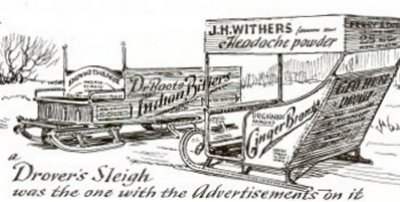![]()

One road traveler who was never bothered by weather, good or bad, was the drover, who was a most remarkable man. When one remembers that a farmer often entrusted his entire years stock to his care, one realizes how sober and reliable a gentleman the drover must have been. He was also one of the first American advertising men. His pung ( sled) was so covered with signs advertising taverns or patent medicines that he seldom needed other identification.
Drovers who walked livestock from the farm to the city often found themselves guardians to a varied group. Cows and sheep and goats were comparatively simple to handle, but geese and turkeys made the drover's life difficult. The drover's dog is a forgotten animal, but it is said that his ability as a herder was amazing. While the drover slept, he depended on his dog to guard his flock and warn him of any irregularity.
Among the feats of a drover was that separating large drives into legal limits for crossing toll bridges. There seemed to be a standard fine of a dollar for any drove "of horses, jacks, mules, or oxen more than ten, at a distance less than thirty feet apart" over a wooden bridge. But it is doubted that a drover ever paid the fine, for he was usually the tollbridge keeper's best customer.
The drover had no standard identifying uniform, although many wore wide-brim hats and large capes. A staff to handle the animals was sometimes supplemented by a long pole with a red flag on it so that stagecoach traffic might be warned of an approaching drove.
Excerpted by Maury Tosi
From Eric Sloane's booklet American Yesterday (1956)